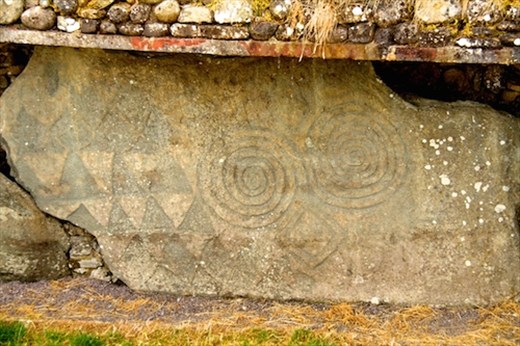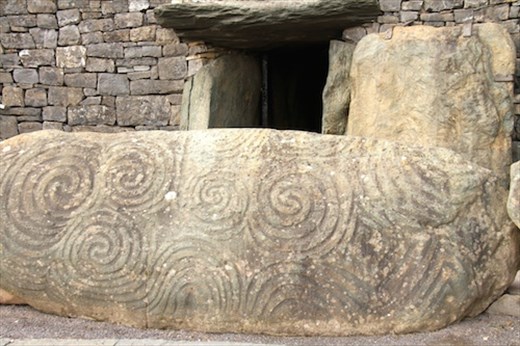BRU NA BOINNE (BEND IN THE RIVER BOYNE) is world famous for its Neolithic passage tombs. It covers 1500 acres and includes the tombs at Knowth, Dowth and Newgrange plus 40 or so satellite tombs and the passage tomb of Newgrange is the “largest roofed structure in Western Europe.” Bru na Boinne is a World Heritage Site and is packed with visitors, especially on this Irish “bank holiday” weekend. The fortifying kerbstones are wonderful, but for my money, the Bru na Boine experience doesn’t compare with the less-known Loughcrew passage tombs.

Carvings on kerbstone, Knowth
While tourists queue up for the OPW buses to ferry them to the tombs at Knowth and Newgrange, Loughcrew is off the beaten track — off the SatNav map as it turns out — up a single-lane track with grass growing in the divider. Knowth and Newgrange may be visited only by guided tours of nearly 50 with a ten-minute maximum stay inside the tomb. To reach Loughcrew you must climb 54 stairs then hike another 400 meters uphill while avoiding sheep poo.

Entrance stone at Newgrange - no photos beyond this point
Since visitors are few you can spend as much time inside as you like. And photos, a no-no at Newgrange, are more than OK, OPW (Office of Public Works) folks even provide a torch to help seek out the carvings. At Newgrange they were more like OPW Nazis, pushing and shoving visitors into line and threatening anyone who pirated a photo. Good grief.

The interior of Loughcrew - stay as long as you like
Both Loughcrew and Bru na Boinne are wonderful reminders that our Neolithic ancestors were resourceful, creative, artistic and spiritual folks. It is good that sites like this that pre-date the pyramids are being preserved. But don’t settle only for the more popular Bru na Boinne. Remember the road less traveled upon; it may make all the difference.

Interior passageway at Loughcrew, mind your head